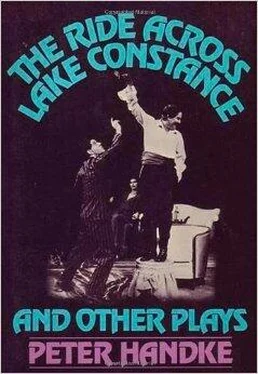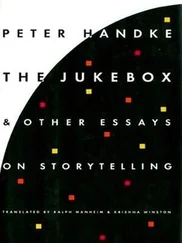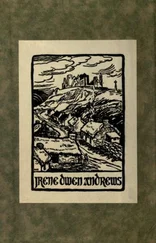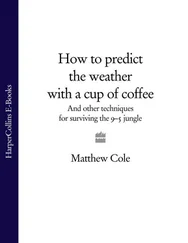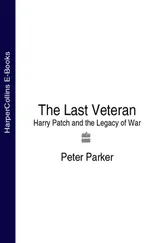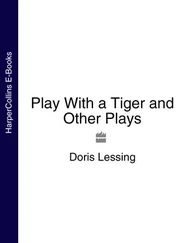Onstage, ward and warden are in the process of rearranging the stage: what was inside before is now turned inside out.
If the stage is of the revolving kind, this process is managed by turning the stage 180 degrees.
If the stage is not of the revolving kind, ward and warden simply turn the backdrops of the cornfield, beetfield, and house façade so that the backs of the backdrops now represent the inside walls of the house.
We look out through the back window, behind which the birds are circling.
Lacking a revolving stage, ward and warden take the objects that stood in front of the house (the object under the rubber coat, etc.) to the back of the stage, and now, as it becomes bright again, they bring the furnishings for the house onstage.
This is what is required for the play: a rather large table, two chairs, an electric hot plate, a coffee grinder, an assortment of bottles, glasses, cups, saucers, and plates (on the floor in back), an oil lamp, a rubber hose, a bootjack, a newspaper which sticks in the crack of the door.
On a nail on the door hangs a bullwhip; on the same nail there also hangs a pair of scissors.
We see a large monthly calendar hanging on what is, from our vantage point, the right wall of the room.
But so that we can see all of this, the following has transpired in the meantime: the warden lit a match in the dark and turned up the oil lamp. As we already know from many other plays, the entire stage gradually becomes bright when someone lights an oil lamp: the same happens here.
Now that the stage is brightly lit — let us not forget to listen to the music, which becomes neither softer nor louder — we see it in the following condition: it now represents the room of a house. But this room is still empty, except for the paper in the crack of the door, the objects on the door, and the calendar.
We see ward and warden, who come onstage from the left and right sides respectively, distribute the aforementioned objects throughout the room: each brings in a chair, then the table is brought onstage by the two of them, then comes the warden with the rubber hose, which he drags across the stage before dropping it, then comes the ward with the bottles and plates, then the warden with the glasses — unhurriedly but not ceremonially either — just as though we weren’t watching; circus workers would go about it differently. No evincing of satisfaction, no contemplation of work well done, no moving to the music.
They both sit down, the ward almost first but he stops midway and the warden is seated, then the ward sits down too.
They both make themselves comfortable.
The music is pleasant.
The warden extends his legs under the table.
The ward also extends his legs under the table and comes to a halt when he touches the warden’s feet; then, after a pause, the ward slowly withdraws his legs; the warden does not withdraw his.
The ward sits there. What to do with his legs?
Quiet, music.
The ward puts his feet on the front crosspiece of his own chair, and to accomplish this he uses his body to shove the chair back, producing the customary sound; the warden doesn’t let himself be disturbed, he replies by taking off his hat and placing it on the table.
Quiet, music.
The ward slowly looks around the room, around, up, and also down, but avoids grazing the warden with his eyes, makes an about-face, so to speak, whenever he is just about to look at the warden: this is repeated so often that it loses its psychological significance.
The warden watches the ward.
The ward stands’up, takes an apple from his pants pocket underneath the coveralls, and puts it beside the hat.
The warden lowers his gaze to the apple.
The ward starts gazing around the room again. What is there to see in the room?
Suddenly, as if he senses a trap, the warden cocks his head.
The ward, caught by the warden’s gaze, stops looking around.
Mutual staring at each other, gazing, mutual looking through each other, mutual looking away. Each one looks at the other’s ear.
The ward places both feet on the floor simultaneously; we can hear it.
The warden looks at the ward’s ear.
The ward gets up carefully, softly.
The warden looks at him, at his ear.
The ward, aware only of himself, goes to the door, his steps, careful at first, becoming progressively louder as he approaches it.
The warden follows him with his eyes.
The ward bends down and pulls the newspaper out of the crack in the door.
The warden does not follow the ward with his eyes but keeps them fixed on the door: what’s hanging on the door?
The ward straightens up, goes back to the table with the paper under his arm, walking progressively more carefully again, once by the table walking almost soundlessly; while underway he uses his free hand to take the paper from under his arm and holds it neatly in his hand by the time he stands before the table.
The warden gazes at the door.
The ward neatly places the paper beside the hat and the apple.
The warden lowers his head; in the pause between the movements we hear a louder chord.
The ward sits down without making a sound, sits the way he did before; the next chord is suddenly softer.
The warden unfolds the paper completely.
He reads. He folds the paper together to the size of one page. He pretends to read that page. He reads so that it is almost a pleasure to watch him reading.
The ward, while seated, pulls, with a good deal of effort, a tiny book out of his pants pocket, the same pants from which he produced the apples, and also reads and is no less pleasant to look at.
The warden folds the newspaper page in half and goes on reading.
The ward pulls a pencil out of his pants pocket, a carpenter’s pencil like the warden’s, only smaller; he uses it to mark in the book while reading.
The warden goes on folding the paper.
The ward no longer marks in his book but crosses something out.
The warden goes on folding as best he can.
The ward is obviously starting to draw in the little book.
The warden folds.
The ward exceeds the margins of the book while drawing and begins to draw on the palm of his hand.
The warden: see above.
The ward draws on the back of his hand.
The warden is gradually forced to start crumpling the paper, but we don’t actually notice the transition from folding to crumpling.
The ward draws on his forearm; what he draws doesn’t necessarily have to resemble the warden’s tattoos.
The warden is obviously no longer reading or folding but is vigorously crumpling.
Both figures are vigorously occupied, one with drawing, the other with crumpling.
The warden completes the crumpling process and the paper is now a tight ball.
The ward is still drawing.
The warden is quiet, the ball of paper in his fist; he looks at his opposite, who is drawing.
The ward is drawing; the longer his opposite gazes at him, the more slowly he draws.
Then, instead of drawing, he merely scratches himself with the pencil and finally turns it around and scratches his arm with the other end; then he pushes the pencil into his arm without moving it. Then he stops doing this and slowly places the pencil next to the hat on the table; he quickly pulls his hand away and places it, slowly, on the forearm with the drawing on it.
The warden places his fist with the crumpled paper on the table and leaves it there.
The ward starts looking around the room once more, up, down, to the side, down along his legs.
The warden unclenches the fist holding the paper ball and places his hand next to it on the table; the paper ball slowly expands.
The music, noticeably louder now, is pleasant.
A period without movement — though that is not to say that the figures become graven images — now follows, unobtrusively introducing the next sequence.
Читать дальше
